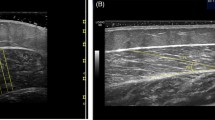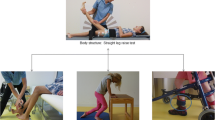Abstract
Purpose
Distal lower limb motor impairment impacts gait mechanics in individuals with cerebral palsy (CP), however, the contribution of impairments of muscle activation to reduced gross motor function (GMF) is not clear. This study aimed to investigate deficits in plantar flexion voluntary activation capacity in CP compared to typically developed (TD) peers, and evaluate relationships between voluntary activation capacity, strength and GMF.
Methods
Fifteen ambulant individuals with spastic CP (23 ± 6 years, GMFCS I–III) and 14 TD (22 ± 2 years) people participated. Plantar- and dorsiflexion strength were assessed with a dynamometer. Voluntary activation capacity was assessed using the interpolated twitch technique via single twitch supramaximal tibial nerve stimulation. GMF was assessed using the timed upstairs test, 10 m walk test, muscle power sprint test and six-minute walk test.
Results
Plantar- and dorsiflexion strength were 55.6% and 60.7% lower in CP than TD (p < 0.001). Although voluntary activation capacity was 17.9% lower on average for CP than TD (p = 0.039), 46.7% of individuals with CP achieved a sufficiently high activation to fall within one standard deviation of the TD mean. Plantar flexion voluntary activation capacity did not correlate with strength (R2 = 0.092, p = 0.314) or GMF measures in the high functioning CP group (GMFCS I–II).
Conclusion
In contrast to previous research, plantar flexion activation capacity did not strongly predict weakness or reduced GMF. We propose that muscle size contributes more to weakness than voluntary activation capacity in high functioning individuals with CP and that relationships between muscle activation and functional capacity are complicated by effects at multiple joints.




Similar content being viewed by others
Abbreviations
- 10mWT:
-
10m walk test
- BMI:
-
Body mass index
- CI:
-
Confidence interval
- CP:
-
Cerebral palsy
- GMF:
-
Gross motor function
- GMFCS:
-
Gross motor function classification scale
- ICC:
-
Intra-class correlation coefficient
- iMVC:
-
Isometric maximum voluntary contraction
- ITT:
-
Interpolated twitch technique
- MPST:
-
Muscle power sprint test
- sEMG:
-
Surface electromyography
- TD:
-
Typically developed
- TUS:
-
Timed upstairs
References
A.T.S. Committee on Proficiency Standards for Clinical Pulmonary Function Laboratories (2002) ATS statement: guidelines for the six-minute walk test. Am J Respir Crit Care Med 166(1):111–117. https://doi.org/10.1164/ajrccm.166.1.at1102
Allen GM, Gandevia SC, McKenzie DK (1995) Reliability of measurements of muscle strength and voluntary activation using twitch interpolation. Muscle Nerve 18(6):593–600. https://doi.org/10.1002/mus.880180605
Barber L, Barrett R, Lichtwark G (2012) Medial gastrocnemius muscle fascicle active torque-length and Achilles tendon properties in young adults with spastic cerebral palsy. J Biomech 45(15):2526–2530. https://doi.org/10.1016/j.jbiomech.2012.07.018
Barber L, Carty C, Modenese L, Walsh J, Boyd R, Lichtwark G (2017) Medial gastrocnemius and soleus muscle-tendon unit, fascicle, and tendon interaction during walking in children with cerebral palsy. Dev Med Child Neurol. https://doi.org/10.1111/dmcn.13427
Damiano DL, Martellotta TL, Sullivan DJ, Granata KP, Abel MF (2000) Muscle force production and functional performance in spastic cerebral palsy: relationship of cocontraction. Arch Phys Med Rehabil 81(7):895–900. https://doi.org/10.1053/apmr.2000.5579
Eek MN, Beckung E (2008) Walking ability is related to muscle strength in children with cerebral palsy. Gait Posture. https://doi.org/10.1016/j.gaitpost.2008.05.004
Elder GC, Kirk J, Stewart G, Cook K, Weir D, Marshall A, Leahey L (2003) Contributing factors to muscle weakness in children with cerebral palsy. Dev Med Child Neurol 45(8):542–550
Gillett JG, Lichtwark GA, Boyd RN, Barber LA (2018a) Functional anaerobic and strength training in young adults with cerebral palsy. Med Sci Sports Exerc. https://doi.org/10.1249/MSS.0000000000001614
Gillett JG, Lichtwark GA, Boyd RN, Barber LA (2018b) Functional capacity in adults with cerebral palsy: lower limb muscle strength matters. Arch Phys Med Rehabil. https://doi.org/10.1016/j.apmr.2018.01.020
Graham HK, Rosenbaum P, Paneth N, Dan B, Lin JP, Damiano DL, Lieber RL (2016) Cerebral palsy. Nat Rev Dis Primers 2:15082. https://doi.org/10.1038/nrdp.2015.82
Herbert RD, Gandevia SC (1999) Twitch interpolation in human muscles: mechanisms and implications for measurement of voluntary activation. J Neurophysiol 82(5):2271–2283
Hussain AW, Onambele GL, Williams AG, Morse CI (2014) Muscle size, activation, and coactivation in adults with cerebral palsy. Muscle Nerve 49(1):76–83. https://doi.org/10.1002/mus.23866
Hussain AW, Onambele GL, Williams AG, Morse CI (2016) Medial gastrocnemius specific force of adult men with spastic cerebral palsy. Muscle Nerve. https://doi.org/10.1002/mus.25477
Moreau NG, Falvo MJ, Damiano DL (2012) Rapid force generation is impaired in cerebral palsy and is related to decreased muscle size and functional mobility. Gait Posture 35(1):154–158. https://doi.org/10.1016/j.gaitpost.2011.08.027
Neyroud D, Armand S, De Coulon G, Sarah RDDS, Maffiuletti NA, Kayser B, Place N (2017) Plantar flexor muscle weakness and fatigue in spastic cerebral palsy patients. Res Dev Disabil 61:66–76. https://doi.org/10.1016/j.ridd.2016.12.015
Nsenga Leunkeu A, Keefer DJ, Imed M, Ahmaidi S (2010) Electromyographic (EMG) analysis of quadriceps muscle fatigue in children with cerebral palsy during a sustained isometric contraction. J Child Neurol 25(3):287–293. https://doi.org/10.1177/0883073809338734
Rose J, McGill KC (2005) Neuromuscular activation and motor-unit firing characteristics in cerebral palsy. Dev Med Child Neurol 47(5):329–336. https://doi.org/10.1017/S0012162205000629
Ross SA, Engsberg JR (2007) Relationships between spasticity, strength, gait, and the GMFM-66 in persons with spastic diplegia cerebral palsy. Arch Phys Med Rehabil 88(9):1114–1120. https://doi.org/10.1016/j.apmr.2007.06.011
Shrout PE, Fleiss JL (1979) Intraclass correlations: uses in assessing rater reliability. Psychol Bull 86(2):420–428. https://doi.org/10.1037/0033-2909.86.2.420
Stackhouse SK, Binder-Macleod SA, Lee SCK (2005) Voluntary muscle activation, contractile properties, and fatigability in children with and without cerebral palsy. Muscle Nerve 31(5):594–601. https://doi.org/10.1002/mus.20302
Taylor JL (2009) Point: The interpolated twitch does provide a valid measure of the voluntary activation of muscle. J Appl Physiol 107(1):354–355. https://doi.org/10.1152/japplphysiol.91220.2008
Verschuren O, Takken T, Ketelaar M, Gorter JW, Helders PJ (2007) Reliability for running tests for measuring agility and anaerobic muscle power in children and adolescents with cerebral palsy. Pediatr Phys Ther 19(2):108–115. https://doi.org/10.1097/pep.0b013e318036bfce
Zaino CA, Marchese VG, Westcott SL (2004) Timed up and down stairs test: preliminary reliability and validity of a new measure of functional mobility. Pediatr Phys Ther 16(2):90–98
Acknowledgements
We gratefully acknowledge the support of Mr Jarred Gillett, PhD, for technical assistance during data collection.
Funding
This work was supported by a National Health and Medical Research Council Postgraduate Scholarship, co-funded by the Cerebral Palsy Alliance Research Foundation [APP1114651].
Author information
Authors and Affiliations
Contributions
All authors contributed to the study conception and design. Data collection and analysis were performed by SO’B. SO’B wrote the first manuscript draft. All authors contributed to data interpretation and editing of the manuscript. All authors read and approved the final manuscript.
Corresponding author
Ethics declarations
Conflicts of interest
The authors have no relevant financial or non-financial interests to disclose.
Additional information
Communicated by Nicolas Place.
Publisher's Note
Springer Nature remains neutral with regard to jurisdictional claims in published maps and institutional affiliations.
Rights and permissions
About this article
Cite this article
O’Brien, S.M., Carroll, T.J., Barber, L.A. et al. Plantar flexor voluntary activation capacity, strength and function in cerebral palsy. Eur J Appl Physiol 121, 1733–1741 (2021). https://doi.org/10.1007/s00421-021-04638-z
Received:
Accepted:
Published:
Issue Date:
DOI: https://doi.org/10.1007/s00421-021-04638-z




